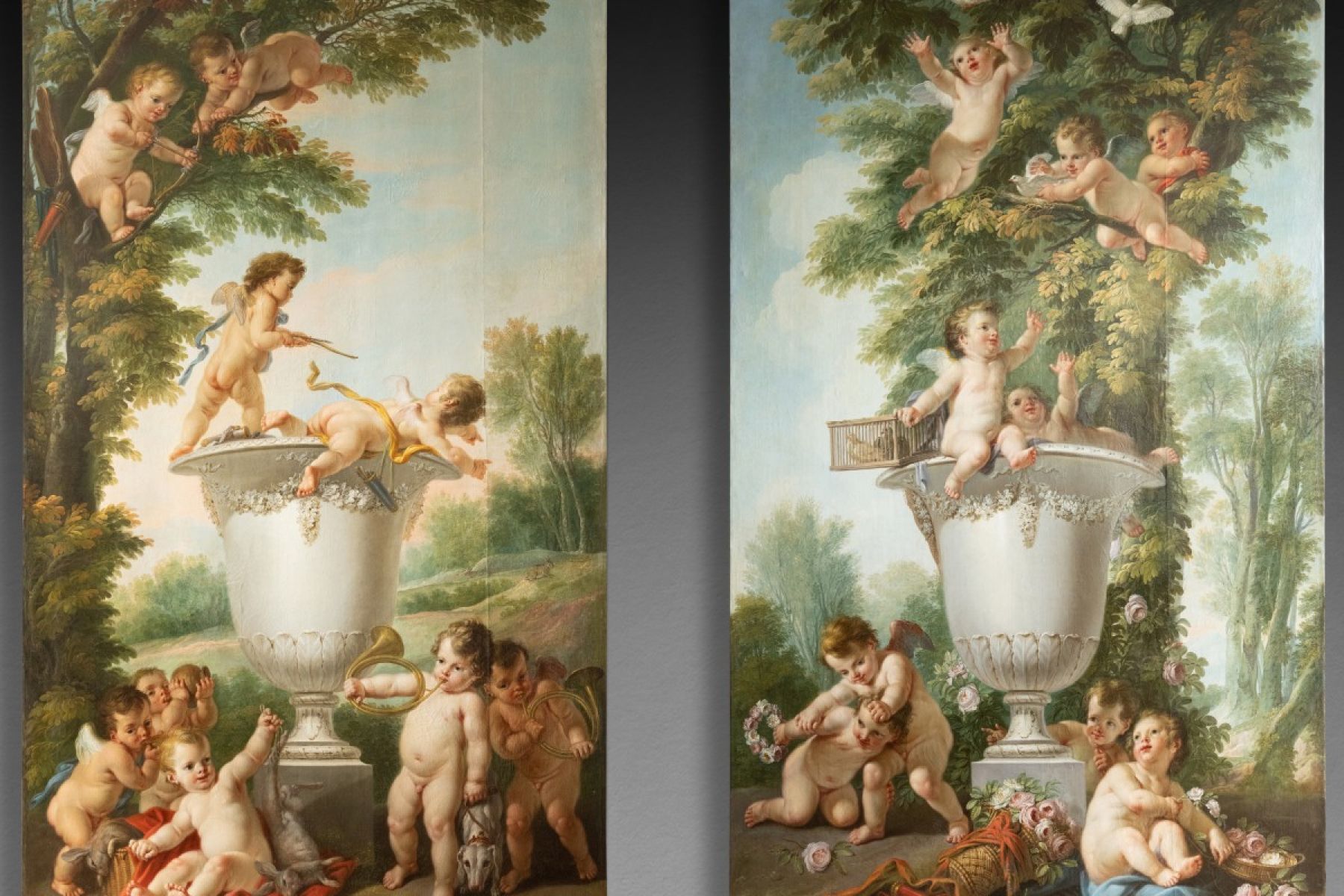Galerie Franck Baptiste
7 quai Voltaire
75007 Paris
FRANCE
Tél. +33 (0)6 45 88 53 58
Monday to Saturday
10h - 13h & 14h - 18h30
- FR
- EN

Paintings
18th century
Joseph François Parrocel
1
Paintings du 18th century
The Fowler Children or The Air, J.F Parrocel 1764
DIMENSIONS : l. 64.76 .inH. 108.07 .in
PRICE : Contact us
REQUEST INFORMATION
?Very important oil on canvas mounted on panel.
Probably from a series of the four elements, it symbolizes the air in the form of young fowler children. The composition is centered around a majestic Medici marble vase with chubby young children at work. On the left we can see Eros and Anteros squabbling over a crown of roses. The man nicknamed Cupid is recognizable not only by his wings but also by his attributes, the bow and quiver that litter the ground.
On the right, two young rose pickers observe them with the greatest interest. Sitting on the ledge and inside the vase, two other children with a birdcage watch over their three companions, who are perched in a tree, trying to capture doves.
Original canvas mounted on a wood panel.
The canvas is signed at the bottom left "J.Parrocel" and dated 1764.
Very good state of preservation, small restorations of use.
Joseph François Parrocel: (December 1704 – December 14, 1781) was a French painter and engraver.
Born into a family of artists, Joseph François Parrocel was born in Avignon and baptized on December 3,
1704. He was the son of Pierre Parrocel who taught him painting and Marie Anne de Seisson.
He married first Françoise Lemarchand and then an Englishwoman, Christine Edwige Ally. He had four
daughters, Jeanne-Françoise (1734-1829), Marie, Thérèse (1745-1835) and Jeannette (1747-1832), all of
whom would become painters.
Like a large majority of French painters of the eighteenth century, he left for Rome in 1717 and settled in
Paris as soon as he returned, which allowed him to join the royal academy in 1731 and to work a few years
later (1740) in the service of Cardinal de Rohan who put him in charge of the decoration of his palace.
In 1751, he was admitted to the Académie St Luc and exhibited at the Salon between 1755 and 1781. He is
very well known for his battle scenes but he is also a great decorator as mentioned by Diderot in 1765.
Indeed, at his peak in the decade 1760-1770, he worked for the king in Choisy, for the royal comedy and
for the Hôtel de la Marine.
Its very rococo décor is largely inspired by that of François Boucher, but it often incorporates very
meticulous architectural elements and particularly lively animals.
Joseph François Parrocel
Joseph François Parrocel: (December 1704 – December 14, 1781) was a French painter and engraver. Born into a family of artists, Joseph François Parrocel was born in Avignon and baptized on December 3, 1704.
He was the son of Pierre Parrocel who taught him painting and Marie Anne de Seisson. He married first Françoise Lemarchand and then an Englishwoman, Christine Edwige Ally. He had four daughters, Jeanne-Françoise (1734-1829), Marie, Thérèse (1745-1835) and Jeannette (1747-1832), all of whom would become painters.
Like a large majority of French painters of the eighteenth century, he left for Rome in 1717 and settled in Paris as soon as he returned, which allowed him to join the royal academy in 1731 and to work a few years later (1740) in the service of Cardinal de Rohan who put him in charge of the decoration of his palace.
In 1751, he was admitted to the Académie St Luc and exhibited at the Salon between 1755 and 1781. He is very well known for his battle scenes but he is also a great decorator as mentioned by Diderot in 1765. Indeed, at his peak in the decade 1760-1770, he worked for the king in Choisy, for the royal comedy and
for the Hôtel de la Marine.
Its very rococo décor is largely inspired by that of François Boucher, but it often incorporates very meticulous architectural elements and particularly lively animals.